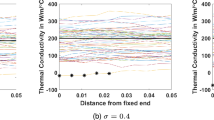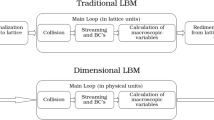Abstract
Energy can transfer internally by radiation in addition to conduction in translucent polymers. Since radiant propagation is very rapid, it can provide energy within the layer more quickly than diffusion by heat conduction. Thus, the transient thermal response of a layer for combined radiative and conduction may be extremely different from that of conduction alone. In this paper, the behavior of a heat conducting, absorbing, and emitting layer of Cellulose Acetate layer is investigated during the transient interval when both conductive and radiative heat transfer are considered. Specifically, the effects of boundary conditions on the response of the layer are considered here. These boundary conditions include both conductive boundary conditions, such as convection coefficient and convective fluid temperature, and radiation boundary conditions, like radiation surrounding temperature and specular reflectivity. To this end, the governing differential equations including the equation of radiative heat transfer within the material coupled to the transient energy equation with radiative terms are presented. The solution procedure is based on nodal analysis and Hottel’s zonal method extended by the ray tracing method. The transient energy equation including the radiative internal energy source is solved using a time marching finite difference procedure with variable space and time increments.










Similar content being viewed by others
Abbreviations
- A k,T_i :
-
Fractional spectral emissive power of spectral band k at nodal temperature T i
- a :
-
Absorption coefficient of the layer (m−1)
- C :
-
Unit heat capacity (Jm−3K−1)
- D :
-
Thickness of the layer (m)
- H 1, H 2 :
-
Dimensionless convective coefficient, H 1 = h 1 / σ T 30 , H 2 = h 2 / σ T 30
- h 1, h 2 :
-
Convection heat transfer coefficient at surface S 1 and S 2, respectively (Wm−1K−1)
- k ie , k iw :
-
Harmonic mean thermal conductivity at the interfaces ie and iw (Wm−1K−1)
- n m,k , n rf,k :
-
Refractive index of the layer and reference, relative to the spectral band k(Δλ k ), respectively
- N :
-
Conduction-radiation parameter, N = k / 4σ T 30 D
- NB :
-
Total number of spectral bands
- NM :
-
Total number of control volumes
- q cd, q cv, q r :
-
Conductive, convective and radiative heat fluxes, respectively (Wm−2)
- \(\tilde{q}\) :
-
Dimensionless flux, \(\tilde {q}=q / \sigma T_0^{4}\)
- S 1, S 2 :
-
Boundary surfaces
- S −∞,S +∞ :
-
Black surfaces representing the surroundings
- (S i S j ) k :
-
Radiation transfer coefficient of surface vs. surface relative to the spectral band k(Δλ k )
- (S i V j ) k :
-
Radiation transfer coefficient of surface vs. volume relative to the spectral band k(Δλ k )
- (V i V j ) k :
-
Radiation transfer coefficient of volume vs. volume relative to the spectral band k(Δλ k )
- t :
-
Physical time (s)
- t*:
-
Dimensionless time, t * = (4σ T 30 / ρ CD)t
- T i :
-
Absolute temperature of control volume i(K)
- T f1, T f2 :
-
Fluid temperature for convection at x = 0, and x = D (K)
- T 0 :
-
Uniform initial temperature of the layer (K)
- T * :
-
Dimensionless temperature, T * = T / T 0
- T S :
-
Temperature of the surrounding (K)
- V i :
-
Volume corresponding to node i
- x :
-
Coordinate in direction across the layer (m)
- X :
-
Dimensionless coordinate, X = x/D
- γ:
-
Transmissivity of surfaces
- Δ t :
-
Time interval
- ɛ1,k , ɛ2,k :
-
Emissivity of surface S 1 and S 2 relative to spectral band k(Δλ k ), respectively
- μ:
-
Direction cosine for angle dependent property, cosθ
- μ c :
-
cos θ c
- θ:
-
Angle of reflection
- θ c :
-
Critical angle of reflection
- κ:
-
Extinction coefficient (m−1)
- ρ s i,k :
-
Specular reflectivity component
- λ:
-
Wavwlength
- σ:
-
Stefan-Boltzmann constant (Wm−2K−4)
- τ, τ0 :
-
Optical depth and optical thickness, repectively
- Φ r i :
-
Radiative source term of node i
References
Viskanta R., Anderson E. E. (1975). Int. J. Adv. Heat Transfer 11:318
Viskanta R. (1985) in Proceedings of the Seventh International Heat Transfer Conferences, Vol 1. Hemisphere, Washington, DC, pp. 103-121
Siegel R. (1996). Int. J. Heat Mass Transfer 39:6
Siegel R. (1996). J. Thermo Phys. Heat Transfer 10:681
Siegel R. (1996). Int. J. Heat Mass Transfer 39:1111
Sharbati E., Safavisohi B., Aghanajafi C. (2004). J. Fusion Energy 23:207
B. Safavisohi, E. Sharbati, and C. Aghanajafi in Proceedings of Fourth International Conference on Computational Heat & Mass Transfer, Paris, pp. 1047–1050 (2005)
P. Sadooghi and C. Aghanajafi J. Vinyl Additive Technol. pp. 28–36 (2005)
Su M. H., Sutton W. H. (1995). J. Thermo Phys. Heat Transfer 9:370
Gorthala R., Harris K. T., Roux J. A., McCarty T. A. (1994). J. Thermophys. Heat Transfer 8:125
Sadooghi P., Aghabajafi C. (2003). J. Fusion Energy 22:59
Petrov V. A. (1997). Int. J. Heat Mass Transfer 40:2241
Wu C. Y., Ou N. R. (1994). Int. J. Heat Mass Transfer 37:2657
Frankel J. L. (1995). J. Thermo Phys. Heat Transfer 9:210
Derevyanko G. V., Koltun P. S. (1991). J. Eng. Phys. 61:680
Ping T. H., Lallemand M. (1989). Int. J. Heat Mass Transfer 32:795–810
Tan H. P., Qizheng, Lallemand M. (1989). J. Eng. Thermophys. 10:295–300
Ho C. H., Özisik M. N. (1987). J. Numerical Heat Transfer 11:321–340
http://www.electronics-cooling.com/html/2001_may_tec hdata.html
G. M. Wallner, W. Platzer, R. W. Lang, Sol. Energy, 79, 583–592 (2005a)
G. M. Wallner, W. Platzer, R. W. Lang, Sol. Energy, 79, 593–602 (2005b)
Author information
Authors and Affiliations
Corresponding author
Rights and permissions
About this article
Cite this article
Safavisohi, B., Sharbati, E., Aghanajafi, C. et al. Effects of Boundary Conditions on Thermal Response of a Cellulose Acetate Layer Using Hottel’s Zonal Method. J Fusion Energ 25, 145–153 (2006). https://doi.org/10.1007/s10894-006-9017-6
Published:
Issue Date:
DOI: https://doi.org/10.1007/s10894-006-9017-6




